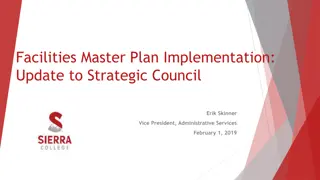
London Population Growth and Infrastructure Challenges
London's population is projected to surpass historical peaks, with growth impacting infrastructure needs. Scenarios are assessed for growth within and outside London, requiring coordination for future planning. Continued growth will demand significant additions to infrastructure, including public transport and housing developments.
Download Presentation

Please find below an Image/Link to download the presentation.
The content on the website is provided AS IS for your information and personal use only. It may not be sold, licensed, or shared on other websites without obtaining consent from the author. If you encounter any issues during the download, it is possible that the publisher has removed the file from their server.
You are allowed to download the files provided on this website for personal or commercial use, subject to the condition that they are used lawfully. All files are the property of their respective owners.
The content on the website is provided AS IS for your information and personal use only. It may not be sold, licensed, or shared on other websites without obtaining consent from the author.
E N D
Presentation Transcript
LSE March 2014 Jeremy Skinner 1
Births Death Net +52 -16 +36 (1.8% of total pop) (0.7% of total pop) (1.2% of total pop) Births Death Net +73 -33 +40 Data in 000 (2006-2010) Assumes current population of 8.4 million Net figures for Inner and Outer London are calculated as averages for 2006-2010
Population scorecard (annual avg thousands - 2006-2010) Inner London - Births 52 Inner London - Deaths 16 Inner London - in-migration overseas 150 Inner London - out-migration overseas 60 Inner London - in-migration UK 95 Inner London - out-migration UK 95 Outer London - Births 73 Outer London - Deaths 33 Outer London - in-migration overseas 85 Outer London - outmigration overseas 45 Outer London - in-migration UK 100 Outer London - outmigration UK 160 Total 555 Total 429 Net growth 146 Net growth from migration 70 Net growth from int ntional migration 130
Londons population is projected to continue growing and will soon exceed its previous peak 000 15,000 Central projection of 11.3 million inhabitants by 2050 High 13.4 million 14,000 13,000 These projections are based on annual employment growth assumptions of 3% (high), 2.5% (central), 2% (low) Within a year we expect to surpass London's 1939 population peak of 8.6 million Central 11.3 million 12,000 11,000 10,000 Overall an increase of 37% from 2011 to 2050 Low 9.5 million 9,000 Consistent with London Plan 8,000 7,000 6,000 5,000 4,000 3,000 2,000 1,000 0 1800 1820 1840 1860 1880 1900 1920 1940 1960 1980 2000 2020 2040 2060 Source: GLA Intelligence Unit 4
We are assessing various scenarios - and their impact on infrastructure needs (and costs) that would accommodate London s growth. Accommodating growth outside London London s projected growth will impact beyond London s boundary, both in terms of economic growth and where people will live and travel between. Accommodating growth within London s borders Coordinated National, Regional and London planning required to plan for growth. New runway? New hub airport? The LEPs will play an instrumental role in supporting that coordination Expanding London s boundaries? New runway? 5
Continued growth will create strong demand for renewal of and additions to London s infrastructure. Some headlines Public transport: 50-60% increase in trips with a continuing shift away from the car, increasingly dense development. Major transport schemes will include Crossrail 2 and 3, road tunnelling, tube and overground extensions, e.t.c. 1.5 million new homes needed between 2020 and 2050 (assuming 50,000 per annum) step change in delivery needed 6,400 primary classes (assuming 30 children per class); equivalent to 300 additional primary schools 3,900 secondary classes, or 130 new schools each year. High risk of demand outstripping supply across various infrastructure types energy in particular in the short term 6






















